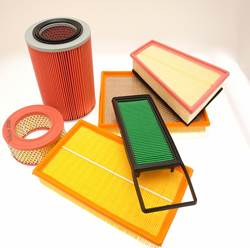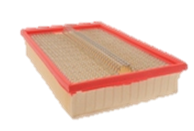Filtration

Air Filter Quality & TechnologyEnsuring that only the cleanest air is used in the combustion process is vitally important in the never ending quest for high engine efficiency and low emissions. The throughput of air required for the average motor vehicle is huge, amounting to 10 cubic meters for every litre of fuel consumed. Filtering such volumes of air without impeding flow is crucial and immediately puts the spotlight on the material used to make the filter and how it is constructed. The typical air filter may look simple enough, but its floppy concertina picture frame appearance belies the technology that has gone into its development and why it is important to only use OEM quality filters. Not only is the material required to filter out micro-sized particles with minimum loss of flow, but as a unit it must also have inherent qualities of:
Filter Material Commonly referred to as ‘paper’, the filter material is based on cellulose fibres impregnated with resins to both stiffen the fabric and provide resistance to moisture, oil, fuel and exhaust fumes. Like paper it can be folded with sharp creases and embossed to create rigidity – both of which are central to creating the simple, open design we see today. Pleating Pleating and making the filter into a cylinder is a common practice as it both increases the surface area and provides rigidity by virtue of the sharp folds and circular shape. This provides a natural resistance to compression as well as a decreased risk of turbulence and of creating noise. The trend for ever smaller engine compartments has meant moving away from round filters to flat, rectangular panels. Pleating is still necessary for surface area and the sharp folds are still needed to provide rigidity across the panel but, depending on the actual size, width to length ratio and air flow, additional reinforcement may be required. These are typically glue beads along the length to keep the pleats evenly separated, and a steel mesh on the outlet side to prevent the panel billowing.
Embossing Embossing the filter paper between the folds to create a series of ridges along the pleats is vitally important to maintaining an even distribution of dust over the whole surface area. High air flow rates rushing through the filter can cause the paper to vibrate, making the filter collect in patches. Embossing helps prevent this, but it has to be properly designed. The difference between a good and poor design can be as much as a 40% reduction in collection capacity. Pre-filters Pre-filters were originally conceived for use in dusty environments, but they can also extend filter life in normal UK conditions. The pre-filter typically consists of sponge layer, 5-10mm thick bonded across the panel pleats. Filter life is extended because larger particles are captured in the sponge layer reducing the risk of clogging on the surface. All Reisse filters are produced to the highest standards by OE manufacturers, giving you OEM quality product at great prices. |
Related Articles Related Downloads |
